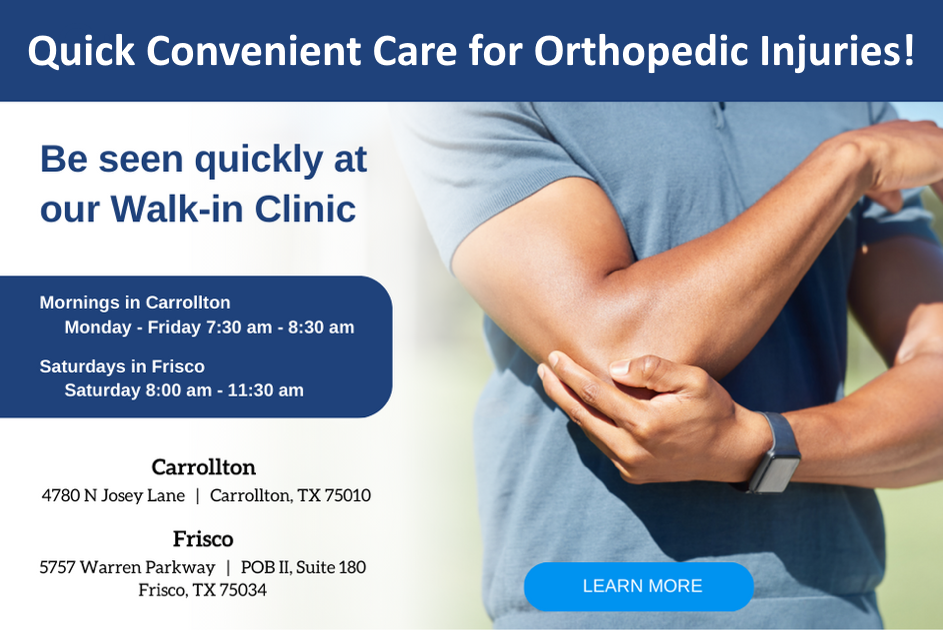When faced with the prospect of orthopedic surgery, whether for a sports injury or to resolve the pain from long-standing wear and tear to a joint, the most common question we are asked in orthopedics is, “How long will it take to recover and get back my activities?” or for athletes, “How long will it take to return to play?”
Good habits, a strong and active body, proper nutrition, and a good mental attitude go a long way in helping someone recovering from surgery. Let’s look at some of the key factors that come into play and that can affect the speed of recovery from an orthopedic surgery.
Age & Physical Health
We encourage patients to give thought to their personal health and the way they take care of themselves, as it can have a substantial impact on their recovery process. Younger patients who are in excellent or even average physical shape typically have a shorter and easier recovery than someone who has had symptoms for a long time or has a higher body mass index (BMI) and sedentary lifestyle. These individuals often have a slower recovery. There are several reasons for that:
- A healthy weight is important, as for each extra pound of weight a person carries, there is 3-5 lbs. of increased pressure on the joint for every step. For example, losing 20 lbs could equate to 60 to 100 lbs. less pressure on a joint.
- The age of the patient is an important factor in recovery because the quality of tissue and the bone health varies in a young patient vs an older patient. If the tissue is less robust, thin, or unhealthy it can affect the healing time and potential.
- Good bone health can also lead to a quicker recovery. We encourage post-menopausal females, who are at risk for decreased bone density, to take vitamin D and calcium to keep their bones in optimal shape. Strength training can also help keep bones strong.
Conditioning Level
Whether you are an athlete or an average joe, your conditioning level can also have a significant impact on the recovery process. It is always ideal to have the body in optimal shape prior to a surgery as it does make the recovery easier and quicker.
- We recommend that all individuals stay active and exercise at least 30 minutes a day, 4-5 times a week. For those with joint pain we recommend low impact activities such as, swimming, Nordic track, stationary bike, an elliptical machine, or even rowing. Many people think that walking is a low-impact exercise, but that is not the case. Anytime your foot leaves the ground there is impact. The body can also see benefits by doing different activities each day instead of one activity. Mix up your exercise by walking one day, swimming another and doing the elliptical one day.
- A healthy diet is also important to keep bones and tissues healthy and maintain an ideal weight. We recommend a diet that is low in sugars, high in fiber and low in fat.
- For some patients, we may prescribe pre-hab or physical therapy before surgery to aid in the recovery process and reduce post-surgery stiffness. We’ve learned that patients can often recover quicker and with less pain if their range of motion is almost complete prior to surgery.
Mental Preparedness & Expectations
Sometimes individuals are mentally prepared for surgery before the body is prepared.
We find that patients do better when they have been dealing with pain for years and they have decided they are ready to have their injury fixed or their joint replaced. When they make the decision after suffering from chronic pain, they have decided the risk is worth the reward.
- Having realistic expectations goes a long way in mentally preparing for surgery. The truth is – the body takes time to heal. None of us, as surgeons or therapists, have a magic wand that we can wave. Some surgeries offer a quick recovery and individuals are back on their feet within a couple of days and back to activities or a high level of play within a few weeks, while other surgeries can take up to a year for complete recovery.
- It is also important to remember that getting back to life is different than getting back to sport. When working with high level athletes we need to make sure that not only is the injury completely healed, but the biomechanics are correct, and that the strength has returned enough to get back to playing sports.
Commitment to Recovery – Do the Work
Last, but very much not least, your recovery is only just beginning when you leave the operating room. Therapy is a very important part of your journey, and no recovery plan is complete without it. A commitment to therapy can greatly impact the recovery time from your surgery.
- Therapy helps with initial stiffness and therapists will help you safely stretch and strengthen the affected area.
- Don’t stop too soon. One thing we see all too often, that impacts a recovery and makes it take longer, is that an individual stops physical or occupational therapy too soon. Unfortunately, most people receive only a limited number of therapy visits through their health insurance provider and often they stop when those sessions are complete. It is important to listen to your doctor and therapist as they will guide you as to how much therapy is needed.
- It is critical that the therapy doesn’t stop when you leave the therapy office. The work needs to continue at home, as directed.
- It is also important to see the right provider for therapy – not a chiropractor or a massage therapist, but an actual physical or occupational therapist who is specially trained to rehabilitate orthopedic injuries.
Their goal of therapy will be to return strength, stretching, flexibility and ultimately increase your stamina, so that you can return to all the things you want to do!


